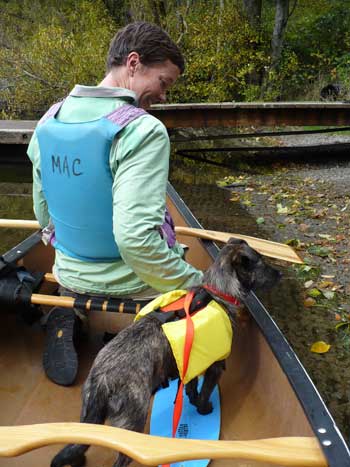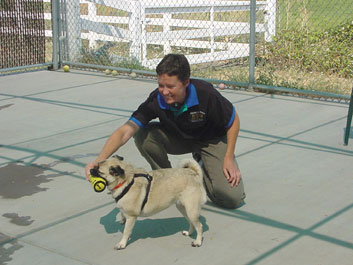THE JOURNEY FROM UNDERDOG TO WONDERDOG
By Robin Dickson, Pres./CEO Dogs for the Deaf, Inc.
 Taking an unwanted, untrained dog from a shelter and turning it into a highly-trained professional Assistance Dog is a far more complex process than most people realize, and we would like to share the highlights of that journey with you.
Taking an unwanted, untrained dog from a shelter and turning it into a highly-trained professional Assistance Dog is a far more complex process than most people realize, and we would like to share the highlights of that journey with you.
At Dogs for the Deaf (DFD), our mission is to rescue dogs from shelters and train them to help people with disabilities. Our trainers regularly go to shelters up and down the West Coast looking for dogs that might be suitable for training. They are looking for dogs who are between ten months and three years of age and who are confident, people- oriented with a desire to please. The trainers first watch the behavior of the dogs in the kennels, looking for very specific things. When they find a dog that scores well in the kennel, they take that dog out of the kennel and spend time getting to know it better. They handle the dog, play with it, give it treats, and go through various tests. Because we are looking for a very select type of dog, many dogs are screened in order to find the few who are suitable for our training. If the dog seems to have the right temperament and motivation, they adopt the dog from the shelter and take it to our training facility outside Central Point.
Upon arriving at DFD, each new dog goes into our quarantine kennel for two weeks. This is important in order to make sure the dog does not have any contagious diseases that could be passed on to the dogs already in training. Each dog also has a thorough medical evaluation by a local veterinarian to make sure the dog is healthy and does not have anything that would prevent it from working to help a person with a disability. All dogs are also spayed/neutered at this time.
After the two weeks in quarantine, the dog is moved to the main kennel, and actual training begins. There is a lot to learn during the next five-six months, and there are actually three parts to the training—obedience, assistance dog skills, and socialization.
 All the dogs learn the basic obedience commands of sit, down, stay, come, and heel. Obedience training takes time and a great deal of repetition until the dog learns to reliably respond to all the obedience commands.
All the dogs learn the basic obedience commands of sit, down, stay, come, and heel. Obedience training takes time and a great deal of repetition until the dog learns to reliably respond to all the obedience commands.
They also must learn the skills that will enable them to help the person they are partnered with. The dogs who are going to be Hearing Dogs must learn how to alert their trainer when various household sounds occur and then take their trainer to the sounds. Autism Assistance Dogs must learn how to serve as an anchor to prevent the child with autism from bolting and running into an unsafe situation such as a street or body of water. They must also learn to handle a variety of behaviors often exhibited by children with autism. Dogs entering our Program Assistance Dog training learn individualized behaviors that will help the professional work with his/her patients. Most all Program Assistance Dogs learn the “go to” command which is their cue to go to the person indicated and interrupt the client’s, student’s, or patient’s inappropriate behavior and bring them back to the task at hand. All of this training is accomplished with positive reinforcement—the dog receives a treat or toy when it does what the trainer wants it to do. All skills being trained must be done over and over and over until the dog works properly regardless of any distractions.
The third, and equally important part of the training, is socialization. Assistance Dogs have public access rights. They are allowed to accompany the person into all public places and on public transportation. From the early days of training, the trainer begins taking the dog into public places—malls, grocery stores, busses, etc. There are countless sights, sounds, and smells that are not normally part of a dog’s world. Future Assistance Dogs must be able to handle things like shopping carts, elevators, crowds, and more while remaining calm and obedient. This is why we need dogs who are very confident and can handle new and different things.
After five to six months of hard work, the dogs who complete their training are ready for placement. Each dog is tested according to Assistance Dog International standards to ensure that the training is complete. Then the trainer looks through our list of applicants who have been screened and interviewed very carefully to find the right applicant for that particular dog. With each dog being different and each applicant having a different personality and lifestyle, it is imperative to find the best match for each dog in order for the match to be successful.
With the applicant chosen, the trainer and dog travel to the person’s home, anywhere in the U.S. or Canada, to begin the placement. For five days, the trainer teaches the person and any family members how to maintain the dog’s training and helps the dog adjust to the new home and new partner.
After the trainer returns from the placement, we maintain continual contact with the client for as long as they are together. This follow up is essential to the success of the working team. We answer questions, help with problems, and rejoice at their successes. Many years later, we are there to help with the retirement or passing of the dog and bringing a new dog into the person’s life.
Since 1977, this process has happened thousands of times. Underdogs have become Wonderdogs. They have saved people’s lives, increased independence and self- confidence, increased safety, and helped people become more productive members of society. The process is time consuming and complex, but it is, oh, so worth it to save dogs’ lives AND help people with disabilities. It is a WIN/WIN situation.
For more information about Dogs for the Deaf, go to dogsforthedeaf.org or call 541-826-9220. Better yet, schedule a time to tour the DFD training facility and see the training first hand.

Good going Robin! That is Emily with Lola on the first picture! Send the article to the Bellingham Herald, I bet they will publish it.